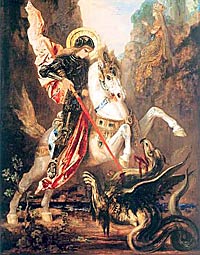Readings:
Joshua 1:1-9
Psalm 3
Revelation 12:7-12
John 15:18-21Preface of Lent (1)
[Common of a Martyr]
[Of the Holy Cross]
PRAYER (traditional language)
Almighty God, who didst commission thy holy martyr George to bear before the rulers of this world the
banner of the cross: Strengthen us in our battles against
the great serpent of sin and evil, that we too may attain
the crown of eternal life; through Jesus Christ our Redeemer, who liveth and reigneth with thee and the
Holy Spirit, one God, for ever and ever. Amen.
PRAYER (contemporary language)
Almighty God, you commissioned your holy martyr
George to bear before the rulers of this world the
banner of the cross: Strengthen us in our battles against
the great serpent of sin and evil, that we too may attain
the crown of eternal life; through Jesus Christ our
Redeemer, who lives and reigns with you and the Holy
Spirit, one God, for ever and ever. Amen.
This commemoration was approved for trial use at General Convention 2024.
Return to Lectionary Home Page
Webmaster: Charles Wohlers
Last updated: 8 March 2025
GEORGE of LYDDA
SOLDIER and MARTYR (c. 304)
 George
is a soldier and martyr who suffered around 303 at Lydda (Diospolis) in
Palestine. The earliest surviving record of him is a church inscription
in Syria, dated about 346. Commemorations of him are numerous, early,
and widespread. However, no details of his life are known. In 495 his
name appears on a list of "good men, justly remembered, whose good
deeds are known only to God." The best-known story about him is that
he rescued a beautiful princess in Libya by killing a dragon. It should
be noted that this story is unknown before the appearance in 1265 of a
romance called the Golden Legend (Legendum Aureum), translated into English
in 1483.
George
is a soldier and martyr who suffered around 303 at Lydda (Diospolis) in
Palestine. The earliest surviving record of him is a church inscription
in Syria, dated about 346. Commemorations of him are numerous, early,
and widespread. However, no details of his life are known. In 495 his
name appears on a list of "good men, justly remembered, whose good
deeds are known only to God." The best-known story about him is that
he rescued a beautiful princess in Libya by killing a dragon. It should
be noted that this story is unknown before the appearance in 1265 of a
romance called the Golden Legend (Legendum Aureum), translated into English
in 1483.
When the soldiers of the First Crusade were besieging Antioch in 1098, they had a vision of George and Demetrius (a deacon of Sirmium in Serbia, martyred under Maximian, and referred to as a "soldier of Christ," from which he was often understood to be a literal soldier) encouraging them to maintain the siege, which ultimately proved successful. Richard I ("the Lion-Heart") of England, who fought in the Holy Land in 1191-1192, placed himself and his army under George's protection, and with the return home of the Crusaders, the popularity of George in England increased greatly. Edward III founded the Order of the Garter in 1348 under his patronage, his banner (a red cross on a white field) began to be used as the English national flag in 1284, and in 1415 Henry V spoke of him to rally the troops before the battle of Agincourt ("Once more unto the breach, dear friends, once more, or close the wall up with our English dead. ... cry God for Harry, England, and St George!"), and in the years following George was regarded as the special patron of England, of soldiers, and of the Boy Scouts, as well as of Venice, Genoa, Portugal, and Catalonia. He is also remembered with enthusiasm in many parts of the East Orthodox Church. He is a principal character in Edmund Spenser's allegorical poem The Faerie Queene, written in the late 1500's.
— by James Kiefer